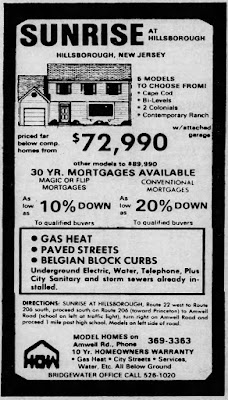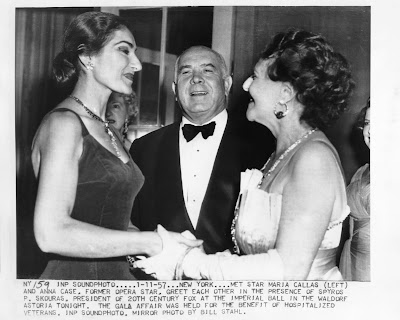Readers who follow the Gillette on Hillsborough Facebook Page are participating in a year-long house-hunting expedition through the real estate ads of yesteryear. In the second 16 weeks, represented by the brief excerpts below, we have taken a look at residential development in the township during the initial phases of the Planned Unit Development period between 1972 and 1980.
Enjoy the recap below, and be sure to follow the Gillette on Hillsborough page by clicking the link here, and "liking" the page. Thanks!
It's 1973 and we are flipping through the real estate ads looking for an apartment or townhouse in Hillsborough's new Planned Unit Development zone. The township began hearing development proposals in 1970 - including some fanciful ones such as a plan by Apollo Improvement Co. for 1,325 apartments and townhouses, a major department store, an indoor-outdoor recreation complex, and a nine-hole golf course for 140 acres on what today would be the southeast quadrant of the Auten/Triangle intersection. One of the first solid proposals to actually get to the building stage was City Financial Corp's Alexandria at Hillsborough project north of Country Club Homes. The plan called for 300 one and two bedroom units on 30.9 acres, and included such amenities as a swimming pool, tennis courts, and air conditioning.
Today we are staying in 1973 to visit City Financial's other big project in the Planned Unit Development (PUD) Zone - Claremont Hills. This project on Auten Road near Amwell Road was planned for 700 garden apartrments, 100 townhouses, and most uniquely, 390 mid-rise apartments in 7-story towers. Like it or not, the three towers in the middle of Hillsborough have turned out to be iconic, and, although not repeated in any other part of town, stand as a representation of the PUD zoning.
We have been stuck in 1973 for a few weeks now - and it's all due to the PUD (Planned Unit Development) zoning. Enacting the ordinance caused property values to skyrocket, and tempted farmers to sell, and developers to buy! The soaring prices can be illustrated by looking at today's featured development - Hillsborough Gardens south of Triangle Road. The 97-acre tract was bought by farmer Stanley Kanach in 1964 for $117,500. He sold it in 1969 for $270,000 to a Princeton based land company. A pretty good deal, but this was eight months before Hillsborough Township enacted the PUD ordinance. At that point, two of the principals in the Princeton company bought out their partners for $300,000 - and then sold the 97 acres to Hillsborough Gardens, Inc. for $915,000! Considering that Hillsborough Gardens was proposing 48 houses and 876 garden apartments, they probably made some money too.
In our quest to reveal the history of Hillsborough Township's post-war residential development through the real estate ads of yesteryear we have finally made it out of 1973! Today we will visit "The Location For Happiness" US Home's Whittier Oaks. Located in the triangle formed by Hillsborough and South Woods Roads, these homes invite you to "Come on...live in the country.....away from confusion yet so close to the city." Did you grow up here in one of the "huge, livable homes...just perfect for growing families?"
Today's ad is for Buena Vista Estates, built in 1974-75 off of Old Somerville and Hamilton Roads. We are still in the era of the "Paneled Family Room" as a major selling point! It was the 70s, after all. What is more interesting than this developpment itself is that in 1973 the developer donated a portion of the property to be used as a Hillsborough community center/youth center. The property was leased by the township for $1 a year to the Hillsborough Youth Council, who spent the next ten years raising money and constructing a building with a solely volunteer effort. In 1983, with an incomplete structure that had also suffered from vandalism, the Youth Council relinquished the lease back to Hillsborough.
Cali Associates of Cranford, NJ was one of the first developers to jump on the Planned Unit Development (PUD) bandwagon. They appeared before the planning board in 1970 for Kimberwyck Village on Auten Road, but the plan needed some major revisions. In fact, the plan wasn't complete until 1973, after Hillsborough had made some revisions to the PUD ordinance.
This week's ad is for the condominium townhouse development along Farm Road known as Hillsborough Village. This development was built in phases, so whereas this ad is from 1975, four years later in 1979 the Hillsborough Township Planning Board was hearing pleas from both the builder and buyers to allow Hillsborough Village to open three buildings before all of the site work required by the Planned Unit Development ordinance was complete. Some buyers had approved mortgages in hand for nearly a year. All the while the list price for the homes had risen from $34,000 to $40,000 to $51,000!
Looking to rent an apartment circa 1974? Beekman Gardens is "The Talk of the Town." These "exravagant", "luxurious" apartments are located south of New Amwell Road on Gemini and Capricorn Drives. Far Out!
Last week our excursion through the the real estate ads of yesteryear brought us to Beekman Gardens. Today, in less than a Bicentennial Minute, we will cross Gemini Drive and visit the townhouses that make up the circa 1976 Beekman Village. Be sure to turn onto New Amwell at the Arco Station!
I just love the ads from today's featured Hillsborough development, Brookside Square. Tennis rackets, pipes, the Good Life circa 1976!
City Financial Corporation broke ground on many projects during Hillsborough's initial wave of Planned Unit Development (PUD) in the 1970s. But perhaps none was more ground-breaking than The Meadows. Located off of the Auten Road extension south of New Amwell, this unique "Quad" development was designed by award winning architect Daniel Cahill, and consists of four clusters, each containing four townhouses, for a total of sixteen units arranged around a central court.
Today's featured development began building on New Amwell Road in 1977 under the name Kenwood Village. By 1978, this handsome townhouse complex was known as Williamsburg Square. This may be the first Hillsborough development to feature a floor plan right in the ad.
Our trek through the real estate ads of yesteryear brings us this week to two late 1970s developments - Brandywine at Homestead and Fox Chase. Brandywine is just south of Homestead Road near Route 206, and Fox Chase is north of Hillsborough Road, east of Willow.
We are closing out the 1970s this weekend with another double dose of vintage Hillsborough real estate ads. I knew where Somerset Woods was located - down Pierson Drive near Route 206 - but I must admit that I was unsure of Sunrise at Hillsborough until I took a drive down Danley Lane and found a home identical to the one in the ad.


















































